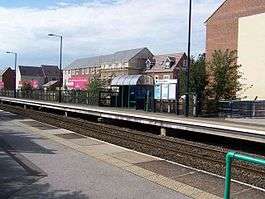Hednesford railway station
| Hednesford | |
|---|---|
 | |
| Location | |
| Place | Hednesford |
| Local authority | Cannock Chase |
| Coordinates | 52°42′36″N 2°00′07″W / 52.710°N 2.002°WCoordinates: 52°42′36″N 2°00′07″W / 52.710°N 2.002°W |
| Grid reference | SJ999124 |
| Operations | |
| Station code | HNF |
| Managed by | London Midland |
| Number of platforms | 2 |
| DfT category | F1 |
|
Live arrivals/departures, station information and onward connections from National Rail Enquiries | |
| Annual rail passenger usage* | |
| 2010/11 |
|
| 2011/12 |
|
| 2012/13 |
|
| 2013/14 |
|
| 2014/15 |
|
| 18 January 1965 | Closed to passengers |
| 6 September 1965 | Closed to goods traffic |
| April 1989 | Reopened to passengers |
| National Rail – UK railway stations | |
| * Annual estimated passenger usage based on sales of tickets in stated financial year(s) which end or originate at Hednesford from Office of Rail and Road statistics. Methodology may vary year on year. | |
| UK Railways portal | |
Hednesford railway station serves the town of Hednesford in Staffordshire, England. The station, and all trains serving it, are operated by London Midland.
History
The station was opened in 1859 on the Cannock Mineral Railway's line from Cannock to Rugeley Town and taken over by the London and North Western Railway a decade later[1] (though the LNWR had worked the line from the outset). It closed to passengers on 18 January 1965 and to goods traffic on 6 September the same year as a result of the Beeching Axe, though the line that passed through remained in use for goods & mineral traffic, serving the power station at Rugeley and various local collieries.
The station reopened in 1989 by British Rail, as the terminus of the first stage of the reopening of the Chase Line from Walsall to passenger trains. At first, there was just a single platform (the current Walsall-bound one); however when services were extended to Rugeley Town in 1997, a second platform was added.
In October 2009 it was reported that the station had been equipped with a PERTIS Permit-to-Travel ticket machine ahead of introduction of a reported extension to London Midland's Penalty Fares scheme from 1 November 2009. The station has undergone improvements with the fitting of a live information system and card ticket machines, completed in April 2010. A minor extension to Platform One was completed in October 2012.[2] The route through the station will be resignalled & electrified in the next few years - the signalling work is due for completion in August 2013[3] (with the signal box here one of those scheduled to close) and electrification will follow by December 2017.
Services
Service frequencies vary. On weekdays there are typically two trains per hour to Walsall and Birmingham at peak times and one train per hour during the off peak period and in the evenings. There are two trains per hour throughout the day on Saturdays with an hourly evening service. Trains operate between Birmingham New Street and Rugeley Trent Valley where connections to Stafford, Stoke-on-Trent and Crewe are available. On Sundays there is an hourly service throughout the day after 10am. Most services are operated by Class 170 diesel trains and journey times are typically 21 minutes to Walsall and 45 minutes to Birmingham New Street. A number of services to/from Birmingham New Street or Walsall start or terminate here.
References
- ↑ Cannock Chase History - Railways Stations around Cannock Chase www.cannockchasehistory.org; Retrieved 2013-08-30
- ↑ "Brand new look now destined for station". Express & Star. 2010-02-11. Retrieved 19 September 2011.
- ↑ Signal Box Closures - Latest News, The South Staffordshire LineSouthStaffsRail website; Retrieved 2013-09-17
External links
| Wikimedia Commons has media related to Hednesford railway station. |
- Train times and station information for Hednesford railway station from National Rail
| Preceding station | Following station | |||
|---|---|---|---|---|
| London Midland |